Sediment Transport and Deposition
What is Sediment?
Sediment refers to the conglomerate of materials, organic and inorganic, that can be carried away by water, wind or ice 3. While the term is often used to indicate soil-based, mineral matter (e.g. clay, silt and sand), decomposing organic substances and inorganic biogenic material are also considered sediment 1. Most mineral sediment comes from erosion and weathering, while organic sediment is typically detritus and decomposing material such as algae 4.
 Sediment particles come in different sizes and can be inorganic or organic in origin.
Sediment particles come in different sizes and can be inorganic or organic in origin.
These particulates are typically small, with clay defined as particles less than 0.00195 mm in diameter, and coarse sand reaching up only to 1.5 mm in diameter 5. However, during a flood or other high flow event, even large rocks can be classified as sediment as they are carried downstream 6. Sediment is a naturally occurring element in many bodies of water, though it can be influenced by anthropogenic factors 8.
Suspended or Bedded?
In an aquatic environment, sediment can either be suspended (floating in the water column) or bedded (settled on the bottom of a body of water). When both floating and settled particles are monitored, they are referred to as SABS: Suspended And Bedded Sediments 4.
Suspended Sediment vs Suspended Solids
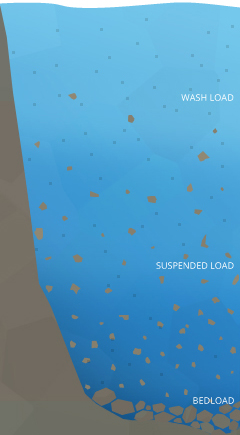
Fine sediment can be found in nearly any body of water, carried along by the water flow. When the sediment is floating within the water column it is considered suspended. In this application, the terms “suspended sediment” and “suspended solids” are nearly interchangeable. The main difference between the two is in the method of measurement 2.
Despite the similarity in meaning, the data provided by the different measurement methods are neither interchangeable nor comparable 2. The suspended sediment concentration (SSC) is in mg/L by filtering and drying an entire water sample. Total suspended solids (TSS), while also measured in mg/L, are obtained by subsampling. While acceptable for homogenized or well mixed samples with very fine sediment, the TSS measurement often excludes larger suspended particles, like sand 2. This means that the SSC measurement tends to be higher and more representative of a water body as a whole, often measuring within 5% of the true particle concentration 7. Due to the incomparability between suspended sediment measurements and total suspended solids measurements, the U.S. Geological Survey recommends SSC analysis over TSS when sampling in surface water 2.
What is Sediment Transport?
Sediment transport is the movement of organic and inorganic particles by water 10. In general, the greater the flow, the more sediment that will be conveyed. Water flow can be strong enough to suspend particles in the water column as they move downstream, or simply push them along the bottom of a waterway 11. Transported sediment may include mineral matter, chemicals and pollutants, and organic material.
Another name for sediment transport is sediment load. The total load includes all particles moving as bedload, suspended load, and wash load 11.
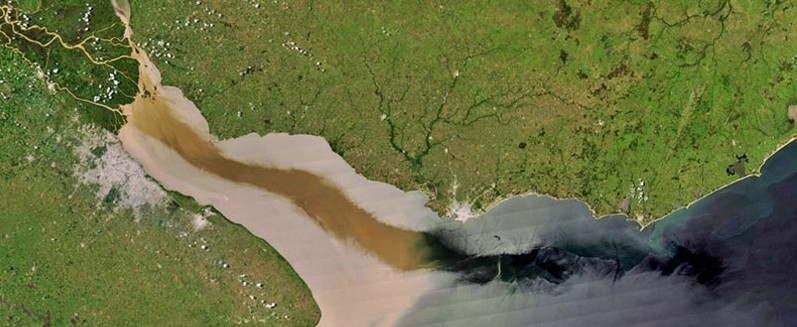
Bedload
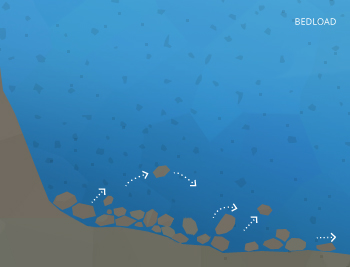
Bedload is the portion of sediment transport that rolls, slides or bounces along the bottom of a waterway 12. This sediment is not truly suspended, as it sustains intermittent contact with the streambed, and the movement is neither uniform nor continuous 11. Bedload occurs when the force of the water flow is strong enough to overcome the weight and cohesion of the sediment 12. While the particles are pushed along, they typically do not move as fast as the water around them, as the flow rate is not great enough to fully suspend them 11. Bedload transport can occur during low flows (smaller particles) or at high flows (for larger particles). Approximately 5-20% of total sediment transport is bedload 10. In situations where the flow rate is strong enough, some of the smaller bedload particles can be pushed up into the water column and become suspended.
Suspended Load
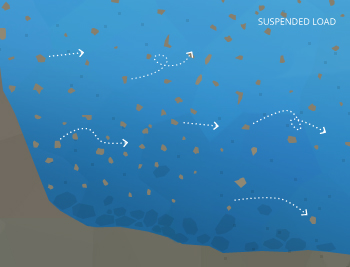
While there is often overlap, the suspended load and suspended sediment are not the same thing. Suspended sediment are any particles found in the water column, whether the water is flowing or not. The suspended load, on the other hand, is the amount of sediment carried downstream within the water column by the water flow 11. Suspended loads require moving water, as the water flow creates small upward currents (turbulence) that keep the particles above the bed 13. The size of the particles that can be carried as suspended load is dependent on the flow rate 11. Larger particles are more likely to fall through the upward currents to the bottom, unless the flow rate increases, increasing the turbulence at the streambed. In addition, suspended sediment will not necessarily remain suspended if the flow rate slows.
Wash Load
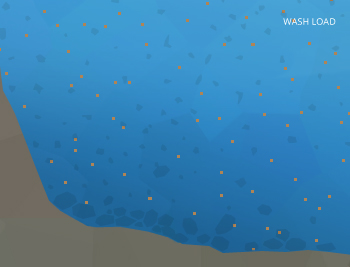
The wash load is a subset of the suspended load 13. This load is comprised of the finest suspended sediment (typically less than 0.00195 mm in diameter). The wash load is differentiated from the suspended load because it will not settle to the bottom of a waterway during a low or no flow period 11. Instead, these particles remain in permanent suspension as they are small enough to bounce off water molecules and stay afloat 11. However, during flow periods, the wash load and suspended load are indistinguishable.
Turbidity in lakes and slow moving rivers is typically due the wash load 8. When the flow rate increases (increasing the suspended load and overall sediment transport), turbidity also increases. While turbidity cannot be used to estimate sediment transport, it can approximate suspended sediment concentrations at a specific location 14.
What is Sediment Deposition?
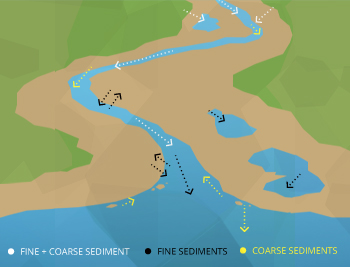
Sediment is necessary to the development of aquatic ecosystems through nutrient replenishment and the creation of benthic habitat and spawning areas 10. These benefits occur due to sediment deposition – when suspended particles settle down to the bottom of a body of water. This settling often occurs when water flow slows down or stops, and heavy particles can no longer be supported by the bed turbulence. Sediment deposition can be found anywhere in a water system, from high mountain streams, to rivers, lakes, deltas and floodplains. However, it should be noted that while sediment is important for aquatic habitat growth, it can cause environmental issues if the deposition rates are too high, or too low.
Settleable Solids
The suspended particles that fall to the bottom of a water body are called settleable solids 10. As they are found in riverbeds and streambeds, these settled solids are also known as bedded sediment 8. The size of settleable solids will vary by water system – in high flow areas, larger, gravel-sized sediment will settle out first. Finer particles, including silt and clay, can be carried all the way out to an estuary or delta 17.
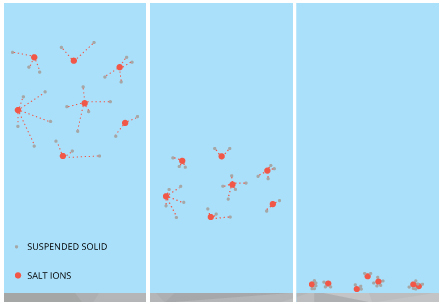 Salt ions can cause suspended sediment to aggregate and sink to the seafloor.
Salt ions can cause suspended sediment to aggregate and sink to the seafloor.
In marine environments, nearly all suspended sediment will settle. This is due to the presence of salt ions in the water. Salt ions bond to the suspended particles, encouraging them to combine with other particles in the water 15. As the collective weight increases, the sediment begins to sink to the seafloor. This is why oceans and other marine ecosystems tend to have lower turbidity levels (greater water clarity) than freshwater environments 15.
While estuaries and other tidal areas may be considered marine, they are not necessarily clearer than freshwater. Estuaries are the collection point for suspended sediment coming down river. Furthermore, in a tidal zone, the constant water movement causes the bottom sediment to continually resuspend, preventing high water clarity during tidal periods 16. The clarity of an estuary will depend on its salinity level, as this will assist with particle deposition 17.
Why are Sediment Transport and Deposition Important?
Many ecosystems benefit from sediment transport and deposition, whether directly or indirectly. Sediment builds aquatic habitats for spawning and benthic organisms 10. It is also responsible for providing nutrients to aquatic plants, as well vegetation in nearshore ecosystems such as floodplains and marshes 10. Without sediment deposition, coastal zones can become eroded or nonexistent.
Sediment and Aquatic Life
Sediment deposition creates habitats for aquatic life. While too much sediment can be detrimental, too little sediment can also diminish ecosystem quality 10. Some aquatic habitats are even grain-size specific. Many spawning habitats require a specific sediment size (e.g. gravel) and too fine of sediment can end up smothering the eggs and other benthic creatures 8.
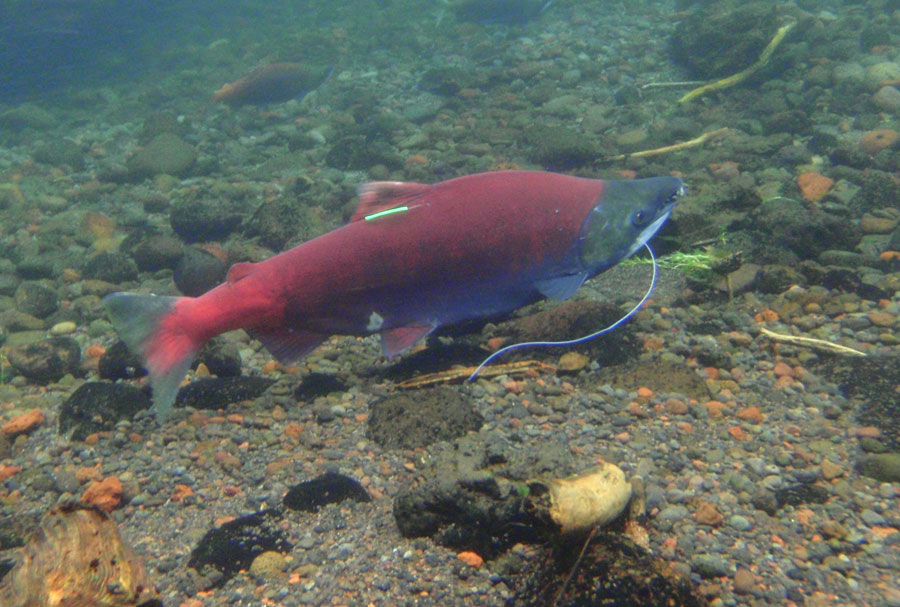
Too much sediment deposition can also bury habitats and even physically alter a waterway. Excessive levels of suspended load tend to have negative impacts on aquatic life. Suspended sediment can prevent light from reaching submerged vegetation and clog fish gills 8. If a body of water is continually exposed to high levels of sediment transport, it may encourage more sensitive species to leave the area, while silt-tolerant organisms move in 8.
On the other hand, too little sediment transport can lead to nutrient depletion in floodplains and marshes, diminishing the habitat and vegetative growth 10. While water clarity is often heralded as a benchmark of water quality, low amounts of turbidity can protect aquatic species from predation 18. In addition, too little sediment deposition can lead to the erosion of riverbanks and coastal areas, causing land loss and destroying the nearshore habitats 10, 18.
Where Does Sediment Come From?
Sediment comes from geologic, geomorphic, and organic factors 10. The amount, material and size of the transported sediment is a sum of these influences in any particular waterway. Sediment transported in rivers with headwaters from a mountain range often include glacial silt, while a body of water surrounded by swampland will be inundated with decomposing organic material 23.
Sediment and Geology
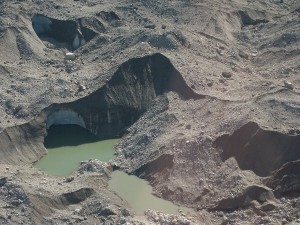
Many sediment particles are mineral-based. The exact nature of the sediment is dependent on location, and the geology of that location 10. Glacial-type sediment is common in mountain ranges, while low-lying rivers are more apt to collect soil-based sediment. In high-flow waterways, sediment transport will include local gravel, pebbles and small rocks. Harder rocks are less likely to become sediment, while soft rocks erode quicker and are easily carried away by flowing water 13. The physical make-up of transported sediment is strongly influenced by the geology of the surrounding environment.
Specific geologic elements are typically localized, such as basalt near volcanic plate boundaries, or limestone in historically shallow marine regions 21. Sediment transport is often responsible for intermixing these geologic features by carrying mineral particle far away from their origin. Mountains streams full of glacial silt can transport that sediment all the way into a tidal bay 10. Likewise, rivers that run through agricultural regions can carry fertilized soil into the ocean 24.
Millions of years ago, sediment deposition helped to form many of these geologic features20. Sedimentary rocks such as sandstone and limestone, are created by sediment deposits, which eventually become pressurized into stone 20. Once these rocks become re-exposed to water and air, the sediment transport process can begin again.
Sediment and Geomorphology
Geomorphology refers to both the surface of the Earth (terrain), and the processes acting on it (e.g. wind and rain) 22. As defined earlier – sediment is the collection of particles that can be carried away by wind, water and ice. These particles can come from the weathering of rocks and the erosion of surface materials 19. When wind, rain, glaciers and other elements scour away a rock face, the particles are carried away as sediment 10. Runoff can carry away top soils, pushing the sediment into nearby streams and rivers.
In addition to the influence of wind and rain, sediment transport is also affected by the local topography 19. The amount of sediment that enters the water and the distance that it travels is due to the terrain that a waterway runs through 13. Bedrock streams are less likely to contribute to the sediment load, as the channel is resistant to quick erosion 13. These rivers, as well as man-made channels with no sediment, are considered non-alluvial channels.
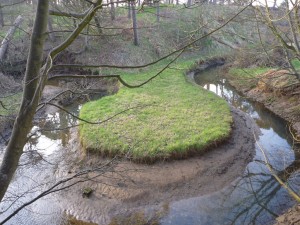
The majority of rivers however, are alluvial, or self-formed 13. Alluvial rivers and streams create their own path by carrying sediment away. In an alluvial stream, the depth and breadth of the waterway will depend on the strength of the water flow and the material that makes-up the channel boundaries 13. Rivers that run through soft soil typically have a higher sediment transport load than rivers exposed to bedrock, as much of the sediment load is taken from the sides and bottom of the channel. In addition to non-erodible bedrock terrains, highly vegetated areas are less subject to runoff erosion during flood events, as the roots of the plants hold the soil in place 19.
In addition to the effects that geomorphology has on sediment transport rates, the process itself plays a part in creating the terrain. As sediment is transported down stream, the water flow helps to shape the planet’s surface by carrying away the eroded material away from some regions and depositing it in others 19.
Sediment and Organic Factors
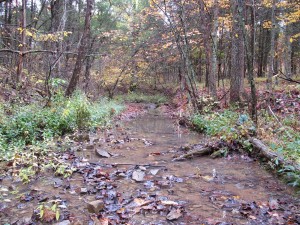
In addition to the mineral-based aspect, sediment can be organic in source. Organic sediment comes from decaying algae, plants, and other organic material that falls in the water (such as leaves) 4. Bacteria attached to this detritus or other inorganic matter are also categorized as organic 18. Organic sediment transport is will vary by location and season. In one estuarine study, the organic portion of the suspended load fell from 85% to 18% from February to November due to seasonal effects on sediment transport 18.
Some phytoplankton can play a unique role in their contribution to sediment loads. In addition to the organic factor they provide, specific phytoplankton (such as diatoms) can contribute an inorganic component as well 1. This inorganic material comes from diatom frustules and calcium carbonate detritus. While this material is not specifically organic, it is organic in origin 1.
Factors that Influence Sediment Transport
Sediment transport is not constant. In fact, it is constantly subject to change. In addition to the changes in sediment load due to geology, geomorphology and organic elements, sediment transport can be altered by other external factors. The alteration to sediment transport can come from changes in water flow, water level, weather events and human influence.
Water Flow
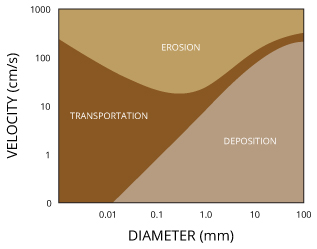
Water flow, also called water discharge, is the single most important element of sediment transport. The flow of water is responsible for picking up, moving and depositing sediment in a waterway 26. Without flow, sediment might remain suspended or settle out – but it will not move downstream. Flow is required to initiate the transport 18. There are two basic ways to calculate flow. Water discharge can be simplified as area (a cross-section of the waterway) multiplied by velocity, or as a volume of water moved over time 25.
Flow (ft3/s) =Area (ft2) * Velocity (ft/s)
OR Flow (ft3/s) =Volume (ft3)/ Time (s)
The equations describing the relationship of water flow and sediment transport are a bit more complex. The complexity of sediment transport rates are due to a large number of unknowns (e.g. bed geometry, particle size, shape and concentration), as well as multiple forces acting upon the sediment (e.g. relative inertia, turbulent eddies, velocity fluctuations in speed and direction) 11. The sediment transport rate in particular is difficult to measure, as any measurement method will disturb the flow and thus alter the reading. Most flow rate and sediment transport rate equations attempt to simplify the scenario by ignoring the effects of channel width, shape and curvature of a channel, sediment cohesion and non-uniform flows 11.
The two main flow factors in sediment transport are the settling rate and the boundary layer shear stress 27. The settling rate (also called Stokes settling) is the rate at which sediment falls through a liquid and it is controlled by the drag force (keeping a particle suspended) and the gravitational force (a function of the particle size) 27. Understanding this relationship helps to define some of the forces that sediment transport has to overcome relative to particle size.
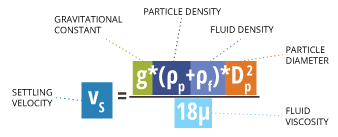
vs = (g * (ρp – ρf) * Dp2) / 18μ
vs = settling velocity
g = gravitational constant
ρp = particle density
ρf = fluid density
Dp = particle diameter
μ= fluid viscosity 29
Shear stresses in the boundary layer of a sediment bed explain how much force is required for water flow to overcome relative inertia and begin sediment transport (through bedload or suspended load) 27.
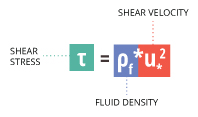
τ = ρf * u∗2
τ = shear stress
ρf = fluid density
u∗ = characteristic velocity of turbulent flow (shear velocity) (see following equations) 27
In a basic freshwater river system, u∗ can be calculated as:
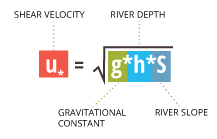
u∗ = Sqrt(g * h * S)
u∗ = shear velocity
g = gravitational constant
h = river depth
S = river slope 27
In the ocean and in other more complex water systems, this equation is inadequate. Instead, the Von Karman-Prandlt equation should be used. The shear stress is influenced not only by the viscosity of the liquid, but the roughness of the sediment 27. The turbulent eddies created at the bottom by water flow must also be accounted for. This is also known as the Law of the Wall 30.
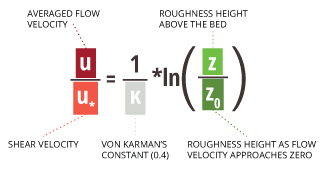
u/u∗ = (1/κ) * ln(z/z0)
u = averaged flow velocity
u∗ =shear velocity
κ = Von Karman’s constant (0.4)
z = roughness height above the bed
z0 = roughness height as flow velocity approaches zero 30
The above equations help to give a basic understanding of some of the forces acting on sediment in the water. To further understand the conditions required for sediment transport, the Shields stress equation can be used. Shields stress, along with the particle Reynolds number, can be used to predict how much flow is required for substantial sediment transport 27. The Reynolds number is an expression of a particle’s resistance to viscous force 28. In other words, the Reynolds number demonstrates whether or not a flow is viscous enough to overcome the relative inertia of sediment. For sediment transport, the Reynolds number for flow through a sediment bed can be calculated from the boundary layer shear stress equation:
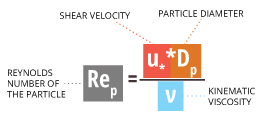
Rep = (u∗ * Dp) / ν
Rep = Reynolds number of the particle
u∗ = characteristic velocity of turbulent flow (shear velocity)
Dp = particle diameter
ν = kinematic viscosity (viscosity/ fluid density, (μ/ρf))27
The point at which water flow begins to transport sediment is called the critical Shields stress 27. This creates an empirical curve to approximate at what flow rate a sediment particle will move (based on particle size) 27.
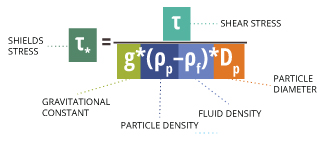
τ∗ = τ /(g * (ρp – ρf) * Dp)
τ∗ = Shields stress
τ = shear stress
g = gravitational constant
ρp = particle density
ρf = density of fluid
Dp = particle diameter 13
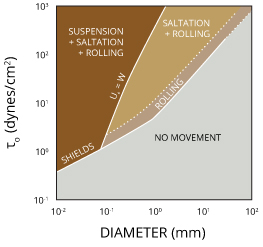
While these equations help define minimum flow rates for sediment transportation, they do not determine sediment load and sediment transport rates themselves. One sediment transport rate equation was developed by van Rijn, for the bedload transport of particles between 0.2-2mm.
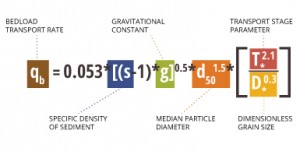
qb = 0.053 * [(s-1)*g]0.5 * d501.5 * [T∗2.1 / D∗0.3]
qb = bedload transport rate
s= specific density of sediment
g = gravitational constant
d50 = median particle diameter
T∗ = transport stage parameter
D∗ = dimensionless grain size 18
The suspended load transport rate (still assuming cohesionless sediment and a sediment size of 0.2-2mm) is even more complicated:
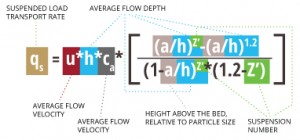
qs = u * h * ca * [ ((a/h)Z’ – (a/h)1.2) / ((1-a/h)Z’ * (1.2-Z’)) ]
qs= suspended load transport rate
u = average flow velocity
h = average flow depth
ca= reference concentration
a = height above the bed, relative to particle size
Z’ = suspension number 18
Other sediment rating curves have been developed, but they cannot be equally applied to all water bodies 13. This is because in any application, there are seven main variables that have an effect on sediment transport rates 11,31.
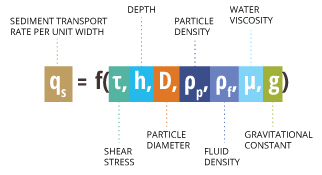
qs = f (τ, h, D, ρp, ρf, μ, g)
qs = sediment transport rate per unit width
τ = shear stress
h = depth
D = particle diameter
ρp = particle density
ρf = fluid density
μ = water viscosity
g = gravitational constant
The sediment transport rate is a function of these seven variables, as well as the size-shape-density distribution (often assumed as a standard deviation of the particle diameter) of the suspended particles 31. In addition, the largest river discharge does not automatically mean that a river will have the largest sediment load. The quantity and material of the sediment particles, as well as the geography of the local terrain will still play a contributing role in the sediment load 10.
The sediment load itself is calculated as a depth-integrated sediment mass above a unit area 11. It is variable for multiple reasons, but can be estimated with a time-average collected sediment concentration 11. While it is dependent on flow to initiate and continue transport, it is not calculated from flow rates, as the main variables in sediment load come from environment factors.
Weather Events and Water Level
Sediment transport relies on water flow to move a load downstream. Water flow is variable, affected not only by the local terrain (e.g. slope), but by water level which, in turn, is influenced by precipitation (or lack thereof).
Most changes in water level are due to weather events such as rainfall 26. Precipitation causes water levels to initially rise, and then return to previous levels (base flow) over the course of hours or days. Rainfall, whether slight or heavy can affect water flow and sediment transport. The extent to which a weather event will influence sediment transport is dependent on the amount of sediment available. Snowmelt in a glaciated area will result in a high sediment load due to glacial silt 10. Heavy rainfall over an area of loose soil and minimal vegetation will create runoff, carrying loose particles into the waterway. Likewise, flooding will also pick up sediment from the local area. In fact, most of an waterway’s sediment load occurs during flood events 10.
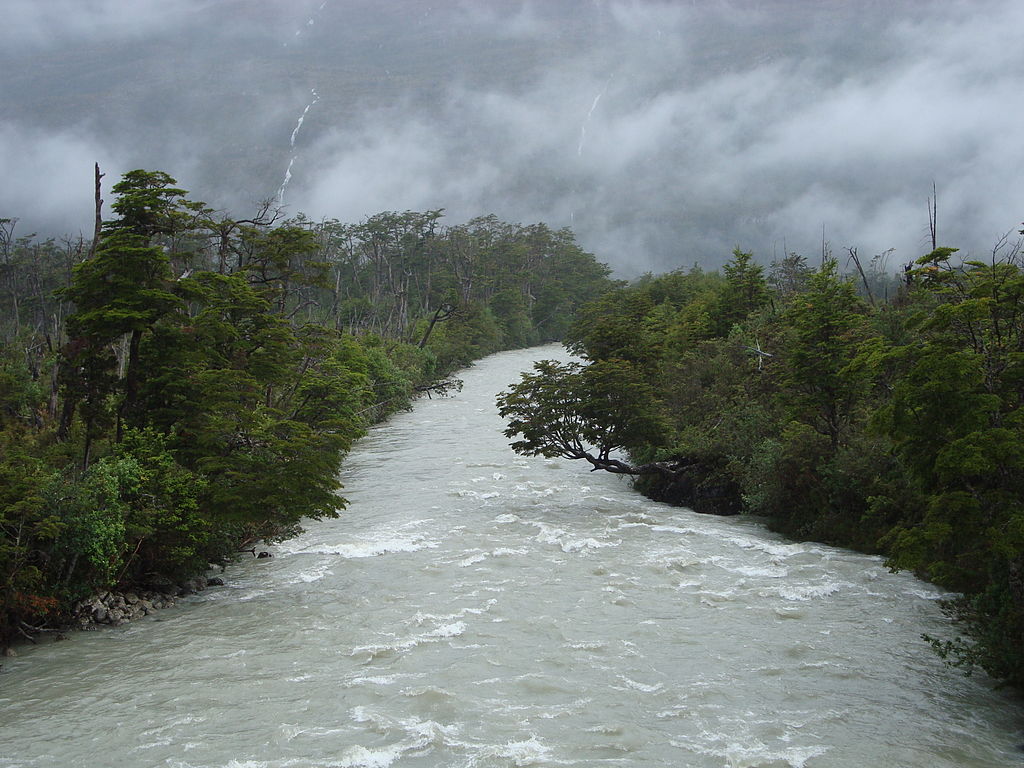
Increased water level creates additional volume in a channel, and increases the hydraulic radius (cross-sectional area of a waterway). The increased hydraulic radius increases the discharge rate, regardless of whether or not flow is uniform or non-uniform 31. Increased flow will increase the stress on the bed, making it more likely for water flow to initiate sediment transport. The higher velocity also increases erosion rates as flow overcomes the shear stress of sediment 13.
Seasonal effects are also responsible for changes in water level and flow 26. Most seasonal changes are due to precipitation levels and events such as snowmelt. During low precipitation and low flow periods, sediment transport falls. During the peak of snowmelt, the sediment load can increase by a factor of 15 or more 13. Climate change can also play a role in sediment transport, as it affects both the timing and magnitude of floods and other weather events 10.
Human Influence
Anthropogenic factors, such as dams and altered land use will affect both the sediment load and sediment transport rate 10. Dams affect the water flow through complete detention or restricted channels 26. The restricted flow can cause the channel downstream of the dam to become “sediment-starved”, while the sediment load behind the dam builds up. A sediment-starved river will not be able to provide habitats for benthic organisms or spawning fish 35. The highly silted reservoir behind the dam may face issues of too much sediment, including changes in aquatic life and the potential for algal blooms. On the other side of the spectrum, when a dam release occurs, the flow rate downstream can dramatically increase. If the release is controlled, it can refresh the bed material, building bars and other habitat areas. An uncontrolled release or dam removal can result in flooding, carrying the released sediment further downstream than is needed 10.
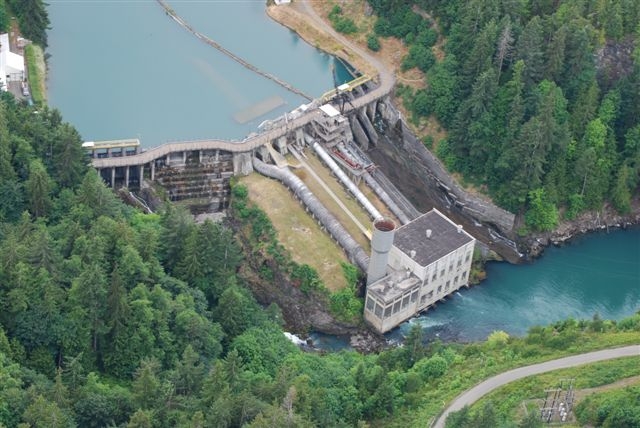
Human land use, such as urban areas, agricultural farms and construction sites will affect the sediment load, but not the transport rate 10. These effects are indirect, as they require heavy rainfall or flooding to carry their sediment into the waterway. However, anthropogenic land use is one of the leading contributors to excessive sedimentation due to erosion and runoff 33. This increase occurs because “disturbed sites” (logging, mining, construction and farm sites) often expose or loosen top soil by removing native vegetation 34. This loose soil is then easily carried into a nearby river or stream by rainfall and runoff.
Consequences of Sediment Transport and Deposition
While sediment is needed to build aquatic habitats and reintroduce nutrients for submerged vegetation, too much or too little sediment can easily cause ecosystem and safety issues. Whether the concerns are caused by scour, erosion, build up, or simply excessive turbidity, the sediment transport rate is an important environmental factor 35. In addition to the problems cause by load quantity, sediment can easily introduce pollution and other contaminants into a waterway, spreading the pollutants downstream 40.
Too Much Sediment
Large sediment loads are the most common issue seen with sediment transport rates. Too much sediment can cause poor water quality, algal blooms, and deposition build-up. For aquatic life, excessive suspended sediment can disrupt natural aquatic migrations, as well damage gills and other organs 8, 37.
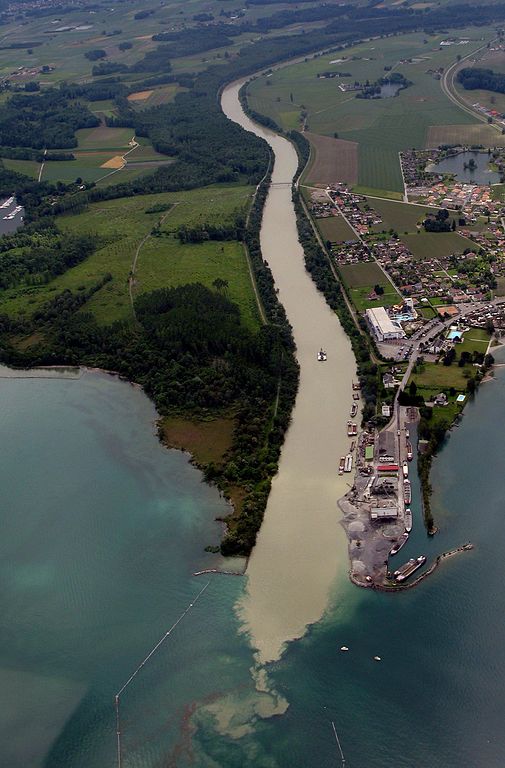
Diminished water quality occurs with unusually high sediment transport rates. Turbidity can cause water temperatures to rise (sediment absorbs more solar heat than water does) 1. Rising water temperatures will cause dissolved oxygen levels to drop, as warm water cannot hold as much oxygen as cold water 37. Suspended sediment can block sunlight from reaching submerged plants, decreasing photosynthesis rates and lowering dissolved oxygen levels still further 38. If the increase in the sediment load is due to agricultural and urban runoff, algal blooms can occur from the increased nutrient load carried into the water body 36.
Regular sediment deposition can build bars for aquatic habitats, but increased sedimentation can destroy more habitats than it creates. Siltation, the name for fine sediment deposition, occurs when water flow rates decrease dramatically. This fine sediment can then smother insect larvae, fish eggs and other benthic organisms as it settles out of the water column 1, 37. Deposition can also alter a waterway’s banks and direction as an unusually high sediment load settles out 35. Sediment deposition is responsible for creating alluvial fans and deltas, but excessive accumulation of sediment can build up channel plugs and levees. These deposits then block the river from reaching other stream threads or floodplains 35. Increased sedimentation is considered one of the primary causes of habitat degradation 36. Depending on the local geology and terrain, sediment build-up can damage aquatic ecosystems not only in downstream sites, but in upstream headwaters as the deposits grow 35.
Sediment deposition is considered extreme when it exceeds the recommended or established total maximum daily load (TMDL). A TMDL establishes a limit for measurable pollutants and parameters for a body of water 35. That means that TMDLs can be created for several different elements of the sediment load, including total suspended solids, nutrient impairment, pathogens and siltation 36.When developing a TMDL report, it is important to consider whether or not the waterway itself is generating the sediment load naturally, as an unstable stream channel 36.
Too Little Sediment
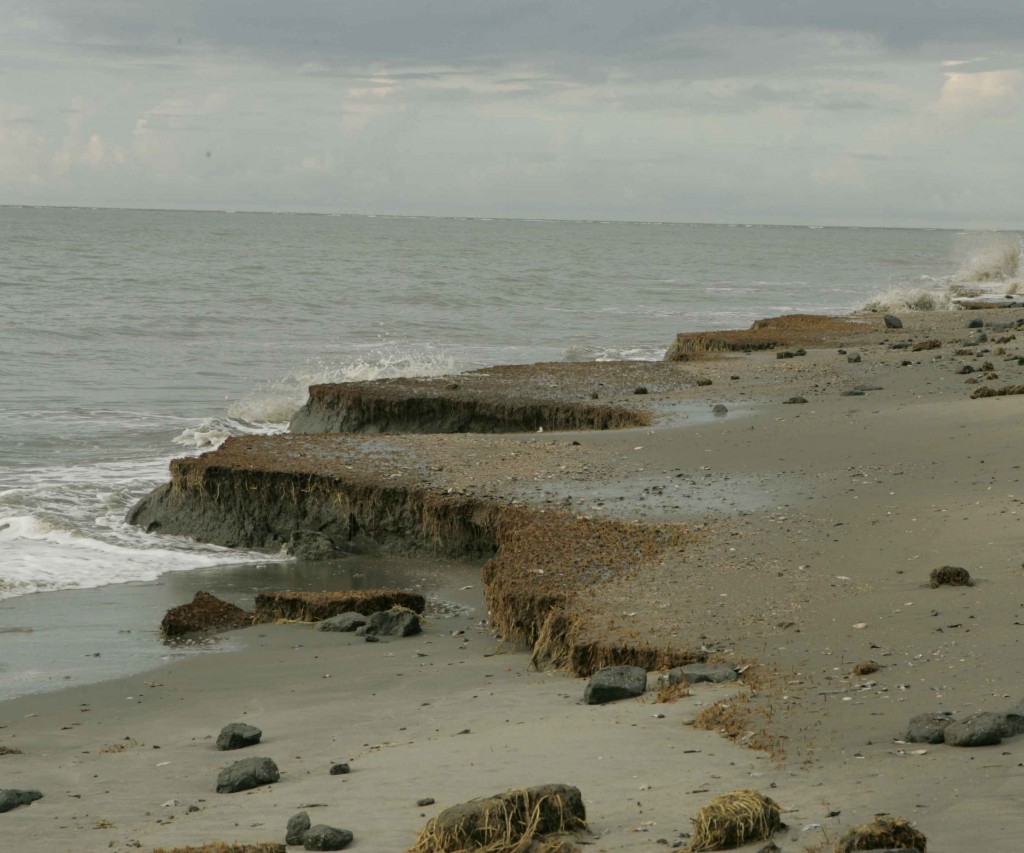
Though too much sediment is the more common concern, a lack of sediment transport will also cause environmental issues. Sediment starvation is often caused by man-made structures such as dams, though natural barriers can also limit sediment transport 8. Without sediment transport and deposition, new habitats cannot be formed, and without some nutrient enrichment (carried with sediment into the water), submerged vegetation could not grow 8. Too little sediment can alter an ecosystem to the point that native species cannot survive.
In addition to the effect on aquatic life, the loss of sediment transport and deposition can cause physical changes to the terrain. Downstream of dammed rivers, it is common to see receding riparian zones and wetlands due to the loss of transported sediment 8. Erosion downstream of a barrier is common, as is coastline erosion when there is not a large enough sediment load currently carried by the water 32. The flowing water will pick up new sediment from the bottom and banks of a waterway (eroding instead of refreshing habitats) as it attempts to adjust to a uniform flow rate 11.
Contaminated Sediment
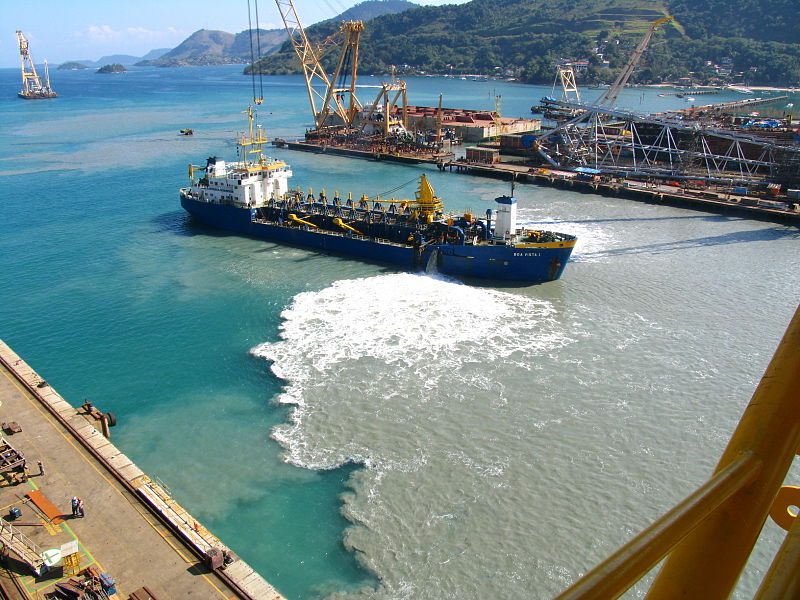
Contaminated sediments are the accumulated riverbed materials that contain toxic or hazardous substances that are detrimental to aquatic, human or environmental health 39. These contaminants often come from point-source pollution (such as industrial wastewater or other effluent sources), though they can also enter the water through runoff over contaminated soils (mine waste, landfills and urban areas), chemical spills, or deposits from air pollution 39.
As contaminants do not degrade (or degrade very slowly), they can be a source of environmental issues for long periods of time, even if they are not frequently resuspended 39. The most problematic contaminants in both bedded and suspended sediment are metals and persistent bioaccumulative toxics (PBTs), such as pesticides and methyl mercury 39.
Sediment remediation may involve dredging to remove the contaminated sediment from the waterway 40.
Scour
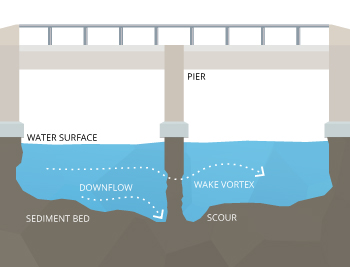
When sediment transport removes material from a streambed or bank, the erosion process is called scour 41. Scour can occur anywhere that there is water flow and erodible material. Local scour is the engineering term for the isolated removal of sediment at one location, such as the base of underwater structures, including bridge piers and abutments 42. This localized erosion can cause structural failure, as bridges and overwater constructions rely on the bed sediment to support them.
While scour can occur anywhere, it is more likely to occur in alluvial waterways (erodible bed and banks), as opposed to a bedrock-based (nonalluvial) channel 41. As water flow is responsible for conducting sediment transport, scour can occur even during low flow conditions. However, critical bridge scour conditions typically occur during periods of high flow, such as during a flood event 41. The higher flow rate can pick up more sediment, and turbulence often occurs at the base of a pier as it interrupts and accelerates the flow. This turbulence in turn will increase the forces acting on a streambed, suspending additional particles and initiating greater sediment transport 41. If too much sediment is removed, the structure can collapse. Scour due to flood-initiated sediment transport is the most common cause of bridge failure in the United States 42.
Cite This Work
Fondriest Environmental, Inc. “Sediment Transport and Deposition.” Fundamentals of Environmental Measurements. 5 Dec. 2014. Web. < https://www.fondriest.com/environmental-measurements/parameters/hydrology/sediment-transport-deposition/ >.
Additional Information
- Sediment Transport Measurement Methods
- Turbidity and Suspended Sediment Measurement Methods
- Sonar
- Applications
- References





